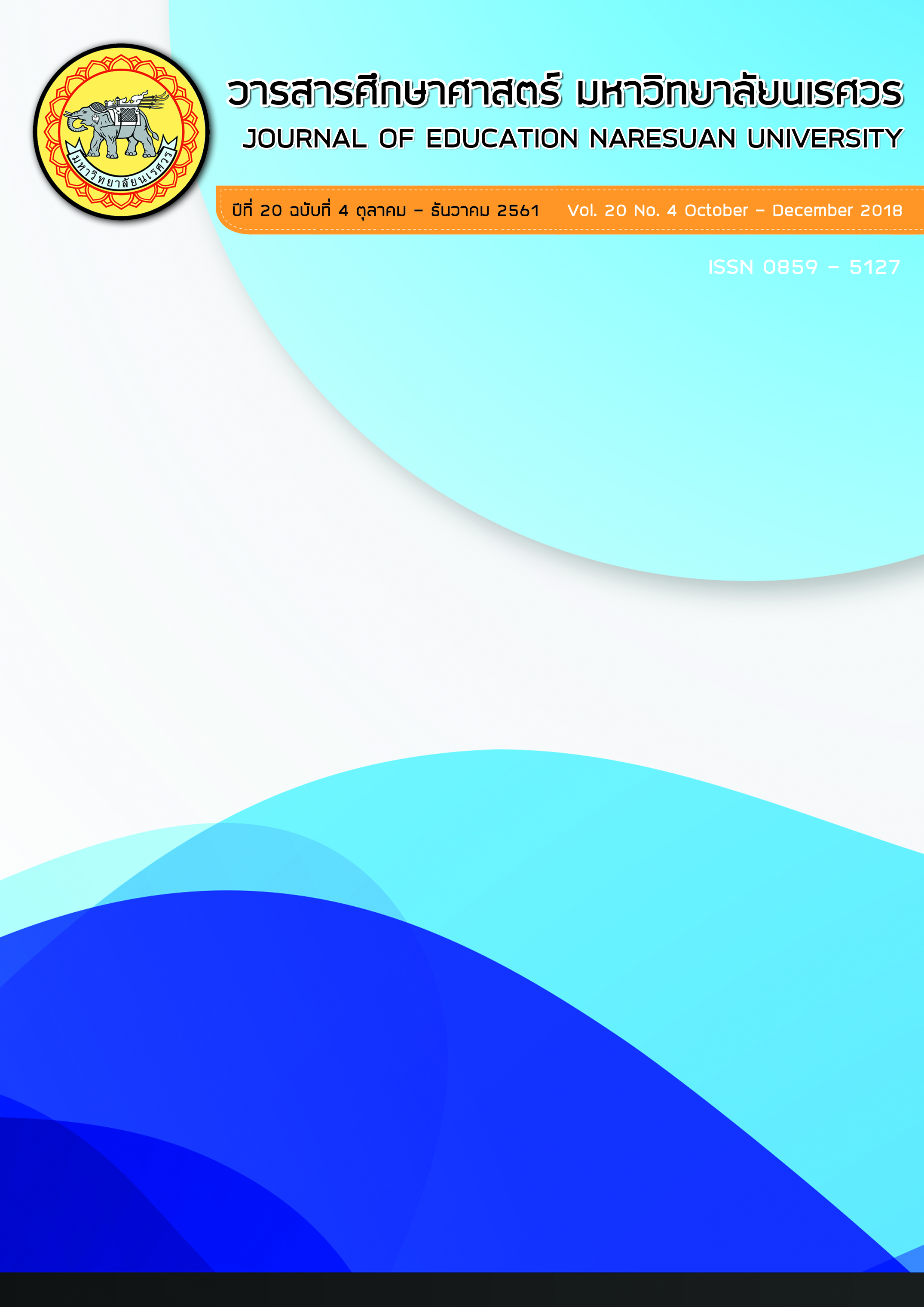การคิดอย่างมีวิจารณญาณในวิชาวิทยาศาสตร์ของนักเรียนชั้นมัธยมศึกษาปีที่ 2 ที่ได้รับการเรียนโดยใช้แผนผังเชิงโต้แย้ง; CRITICAL THINKING ABILITY IN SCIENCE OF GRADE 8 STUDENTS LEARNED THROUGH ARGUMENT MAPPING
Main Article Content
Abstract
งานวิจัยมีวัตถุประสงค์เพื่อศึกษาผลของการจัดการสอนโดยใช้แผนผังเชิงโต้แย้งต่อความสามารถทางการคิดอย่างมีวิจารณญาณในวิชาวิทยาศาสตร์ เรื่อง อาหารกับการดำรงชีวิตและระบบต่างๆ ในร่างกายมนุษย์ กลุ่มเป้าหมายเป็นนักเรียนชั้นมัธยมศึกษาปีที่ 2 โรงเรียนบ้านหนองเขียว อำเภอเชียงดาว จังหวัดเชียงใหม่ จำนวน 23 คน และดำเนินการวิจัยในภาคเรียนที่ 1 ปีการศึกษา 2557 เครื่องมือที่ใช้ในการวิจัยประกอบด้วย 1) แผนการจัดการเรียนรู้วิชาวิทยาศาสตร์โดยใช้แผนผังเชิงโต้แย้ง เรื่อง อาหารกับการดำรงชีวิตและระบบต่างๆ ในร่างกายมนุษย์ จำนวน 9 แผน ซึ่งผ่านการประเมินของผู้เชี่ยวชาญการสอนวิทยาศาสตร์ 2) แบบทดสอบวัดความสามารถทางการคิดอย่างมีวิจารณญาณ (KR – 20 = 0.78) ซึ่งวัดจากองค์ประกอบของการคิดอย่างมีวิจารณญาณตามแนวทางของ Watson และ Glazer ได้แก่ การอนุมาน การกำหนดข้อสันนิษฐาน การนิรนัย การตีความและประเมินข้อโต้แย้ง จากการวิเคราะห์คะแนนความสามารถทางการคิดอย่างมีวิจารณญาณก่อนและหลังเรียนโดยพิจารณาจากค่า Effect size (d) พบว่า ภาพรวมมีค่าเท่ากับ 0.63 แสดงว่าคะแนนเพิ่มขึ้นในระดับปานกลาง แม้ว่าคะแนนองค์ประกอบบางด้านไม่เพิ่มขึ้นเท่าที่ควร ผลการวิจัยนี้แสดงให้เห็นว่า การจัดการเรียนการสอนโดยใช้แผนผังเชิงโต้แย้งสามารถพัฒนาความสามารถทางการคิดอย่างมีวิจารณญาณได้ระดับหนึ่ง อย่างไรก็ตาม แนวทางการจัดการเรียนรู้ควรจะได้รับการปรับปรุงในรายละเอียดอีกพอสมควรเพื่อพัฒนาความสามารถในการคิดอย่างมีวิจารณญาณของนักเรียน
CRITICAL THINKING ABILITY IN SCIENCE OF GRADE 8 STUDENTS LEARNED THROUGH ARGUMENT MAPPING
This research was conducted in order to see the effect of argument mapping based teaching approach on critical thinking ability in science learning on the topic of Food, Living and Systems in Human Body. The target group was 23 grade-8 students of Bann Nong-Keo School, Chiang Dao, Chiang Mai and this research was carried out in the 1st semester of 2013 academic year. The research tools were 1) a total of 9 argument mapping based teaching plans of the subject which were examined by a number of experts prior to the instruction, 2) a critical thinking ability scale in the topic of Food, Living and Systems in Human Body (KR – 20 = 0.78) which measured along 5 dimensions accordance with the Watson-Glaser’s critical thinking appraisal i.e., inference, recognition of assumption, deduction, interpretation, and evaluation of argumentation. The pre and post scores of critical thinking scale were analyzed to see the effect size, it is seen that, in overall, the size was 0.63 which implies that score increases and fall in a medium level. However, the score of some separate dimensions of the critical thinking ability do not increase as expected. The results indicate that the argument mapping based approach implemented in this study considerably helps develop students’ critical thinking ability. However, in details, some refinements would be required to fulfill in order to improve students’ performance.
Article Details
The owner of the article does not copy or violate any of its copyright. If any copyright infringement occurs or prosecution, in any case, the Editorial Board is not involved in all the rights to the owner of the article to be performed.
References
Austhink. (2007). Argument mapping critical thinking on the web. Retrieved December 3, 2012, from http://www.austhink.org/critical/pages/argument_mapping.html
Bangkok Post online. (2011). Thai student got one of the lowest score of PISA Test. Scholar indicated that student lacked of critical thinking. Retrieved December 14, 2013, from http://www.bangkokbiznews.com/home/detail/politics/education/ (in Thai)
Chatmaneerungruang, S., & Thongnoppakhun, W. (2013). The academic skills of the 21st century. The Challenges in the Future. Phuket: Phuket Rajabhat University. (in Thai)
Choangchan, A., & Lowriendee, W. (2011). The development of instructional model for the enhancement of problem solving with critical thinking abilities in science of fifth grade students. Silpakorn Educational Research Journal, 2(2), 94 – 107. (in Thai)
Christian Voigt. (2013). So, what exactly is an argument map? Retrieved December 3, 2012, from http://timvangelder.com/2009/02/17/what-is-argument-mapping
Cohen, J. (1988). Statistical power for the behavioral sciences. Hillsdale, NJ.: Erlbaum.
Dwyer, Christopher Peter. (2011). The evaluation of argument mapping as a learning tool. Galway: School of Psychology National University of Ireland.
Dwyer, C. P., Hogan, M. J., & I. Steward. (2011). The evaluation of argument mapping as a learning tool: comparing the effects of map reading versus text reading on comprehension and recall of argument. Thinking Skill and Creativity journal, 5(1), 16 - 22.
Facione, P. A. (1990). Critical thinking: a statement of expert consensus for purposes of educational assessment and instruction. California: The California Academic Press.
Harrell. (2008). Using argument diagramming software in the classroom. Teaching Philosophy, 28(2), 163 – 177.
Kaewdang, R. (2000). Revolution of Thai education. Bangkok: Matichon Publishing. (in Thai)
Khemmani, T. (2001). The science of thinking. Bangkok: The Master Group Publishing. (in Thai)
Larkin, J., & Simon, H. (1987). Why a diagram is (sometimes) worth ten thousand words. Cognitive Science, 11, 65–99.
Ministry of Education. (2008). The Basic Education Core Curriculum B.E. 2551. Bangkok: Agricultural Cooperatives of Thailand. (in Thai)
Ministry of Education. (2011). The National Education Act of B.E. 2542. Retrieved December 14, 2013, from www.moe.go.th/moe/th/news/detail.php?NewsID=9319&Key= news_research (in Thai)
Pornseema, O. (2000). Thinking. Bangkok: Srinakharinwirot University. (in Thai)
Thongchumnum, P. (2004). Taeching Science in Primary School. Bangkok: Odeon Store. (in Thai)
Van Gelder, T. (2003). Enhancing deliberation through computer supported argument mapping. Visualizing Argumentation: Software Tool for Collaborative and Educational Sense – Making, 97 – 115.
Watson, G., & Glaser, E.M. (1980). Watson and Glaser critical thinking appraisal manual. New York: Harcourt, Brace and World.
Wattakanon, S. (2011). How is Critical Thinking? Thammasat Journals, 31(1), 37 – 42. (in Thai)


